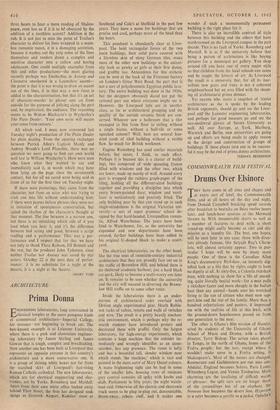ARCHITECTURE
Prima Donna
ENGINEERINO laboratories, long constrained in classical temples or the more pompous kinds of commercial architecture—Imperial College, for instance—are beginning to break out. The best-known example is at Leicester University, where there is a pink and aluminium engineer- ing laboratory by James Stirling and Jam-es Gowan that is tough, complex and breathtaking. Now another one has been built at Liverpool that represents an opposite extreme in this country's architecture and a More conservative one. It is a group of shining white boxes not far from the starched skirt of Liverpool's fast-rising Roman Catholic cathedral. The new laboratories, which are for electrical engineering and elec- tronics, are by Yorke, Rosenberg and Mardall. Apart from their own white office tucked away behind Fleet Street, the firm has designed such things as Gatwick Airport, Keddies' store at
Southend and Cole's at Sheffield in the past few years. They have a name for buildings that are precise and cool, perhaps more of the head than the heart.
This penchant is abundantly clear at Liver- pool. The bold rectangular forms of the two main buildings, their solid parts covered with a lilywhite skin of shiny German tiles, make most of the other new buildings at the univer- sity look as gawky as girls at their first dance, and grubby too. Antecedents for this esthetic can be seen at the back of the Firestone factory on London's Great West Road, the part that is not a sort of polychromatic Egyptian public lava- tory. The entire building was done in the 1930s, but the designers obviously dared not put the rational part out where everyone might see it. However, the Liverpool labs are in another class, as far as architectural grouping and the quality of the outside ceramic, finish are con- cerned. Whoever saw a bathroom that a tiler managed to line from floor to ceiling without a single hiatus, without a half-tile or some squished cement? Well, here are several hun- dred yards of tiled building without a visible flaw. Sa much for British workmen.
Eugene Rosenberg has used similar materials before, but never, I think, to such effect. Perhaps it is because this is a cluster of build- ings, two composed of wide spanning frames filled with windows and the other two, which are lower, made up mostly of wall. Around every part is wrapped the ruthless graph-paper of the tiling, holding all the different-sized buildings together and providing a discipline into which every brown-painted door, window and venti- lator is meticulously and precisely fitted. The only building near by that can stand up to such single-mindedness is the original Victorian uni- versity—a sort of super grammar school de- signed by that hard-headed, Liverpudlian roman- tic, Alfred Waterhouse. The years have been kind to Waterhouse, far, as the university has expanded and new departments have been created, further buildings have been added to his original U-shaped block to make a court- yard.
The electrical laboratories, on the, other hand, like the true sons of twentieth-century industrial architecture that they are, proudly face out on to the traffic of Brownlow Hill, and behind them is no sheltered academic harbour, just a hard black car-park, likely to become a multi-storey one later on. It remains to be seen whether the university and the city will succeed in diverting the Brown- low Hill traffic on to some other route.
Inside the laboratories there is an under- current of architectural order overlaid with Dexion angle experimental gear, Heath Robin- son racks of valves, retorts and walls of switches and wire. The result is a pretty beastly mechan- istic environment, which is perhaps why the re- search students have introduced posters and decorated them with graffiti. Only the largest laboratory, for high-energy experiments, which contains a huge machine that the outsider im- mediately and wrongly identifies as an atom- smasher, has any presence. The room is lofty and has a beautiful tall, slender window near .which stands `the machine,' which is vast and painted in the most outré of Mary Quant colours. A more frightening sight can be had in some of the smaller labs, housing rows of ominous grey control consoles all spiky with knobs and dials. Parliament in fifty years; the night watch- man said. Otherwise all the electric and electronic truck seems to be plug in-plug out, demountable, throw-away, rebore stuff, and it makes one
wonder if such a monumentally permanent building is the right place for it.
There is also an incredible contrast of style between this building and the others that have mushroomed on the Liverpool campus in -the past decade. This is no fault of Yorke, Rosenberg and Mardall. It is as if the university believe that being a patron of architecture is like buying pictures for a municipal art gallery. You shop around till you have one of every major style so that children from the local schools can come and be taught the history of art. At Liverpool the result is a university that, for all its mar- vellous new grass and trees, is not a coherent neighbourhood but ao area filled with the shout- ing of architectural prima donnas.
Yet anyone who wants a snapshot of 'sixties architecture as she is spoke by the leading British exponents, should go and see the Liver- pool and the Leicester engineering laboratories, and perhaps for good measure go and see the neo-mediaeval glories of Sussex University as well. All over Europe, at York, Marburg, Warwick and Berlin, new universities are going up and efforts are being made to apply reason to the design and construction of groups of buildings. If these places turn out to be success- ful it may be the end of prima donna architecture.
TERENCE BENDIXSON






































 Previous page
Previous page